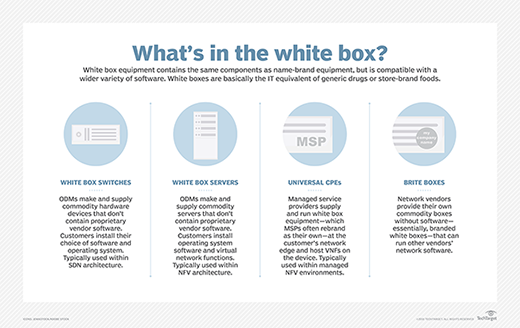white box server
What is a white box server?
A white box server is a data center computer that is not manufactured by a well-known name-brand vendor. White box servers can be found in large data centers run by tech giants like Facebook or Google.
The phrase white box indicates that the equipment is generic or brand-agnostic. The server can be any color.
ODM companies and white boxes
White box servers are usually purchased in bulk quantities from suppliers called original design manufacturers (ODMs). An ODM typically builds their servers with commercial off-the-shelf (COTS) components that can be assembled in slightly different ways or upgraded to provide the customer with a degree of system customization.
An organization can construct and customize a white box server in-house from commercially available retail computer parts; however, an ODM can manufacture and deliver customized servers faster and offer warranty protection for parts. Quanta and Hon Hai's Foxconn are among the ODMs that make white box servers.
Depending on the components, white box server capabilities could rival the CPU, memory and network connectivity of any name-brand server. White box servers can run major enterprise OSes, including RHEL and Windows, as well as virtualization software. Typical white box deployments use clustering techniques to provide high availability (HA) and lower the risk of unexpected downtime.

Keeping costs low
Although there are no standards or requirements for white box server design, an increasing number of white box products are built using designs promoted by the Open Compute project.
Redundant and high-reliability components are less common in white box designs than in name-brand enterprise-grade servers. White box servers are often constructed simply, with more modest functionality than proprietary name-brand systems. This keeps costs low, an important consideration in commodity computing environments.








